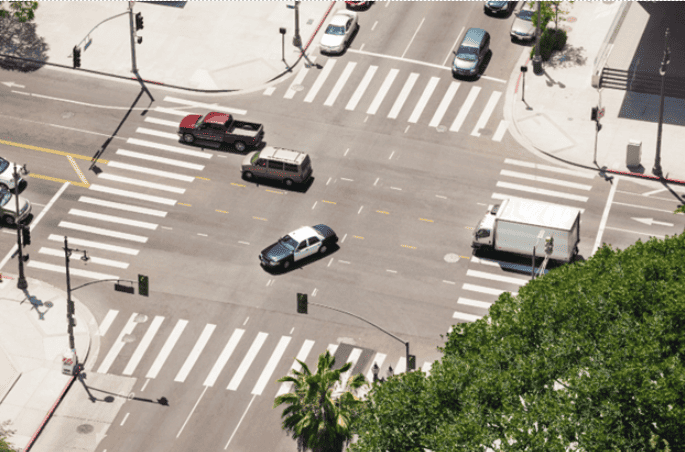- Need Any Help: +1 647-760-5505 or
- info@trubicars.ca
Whether you are a new driver learning to drive or have just passed your driving test, one of the most dangerous things we will do while operating a vehicle is turning left at a traffic light. There are risks associated with this turn that we must all realize and not take for granted. Learning how to make this turn from a qualified driving instructor helps tremendously. Trubicars wants to ensure that this turn is completed safely.
With that all being said, here are a few tips to help you make the turn the safest possible. Let us understand why making the left turn at a traffic light can be so dangerous before identifying ways to reduce the risks and make the turn safely.
You must realize that you are making a turn across the path of oncoming traffic. That is a risk, but not the only risk. When you are facing a green light, the pedestrians will also have their crosswalk ‘walk’ light showing, which gives them permission to walk across the street through the crosswalk.
This means that as you turn, you are driving through their crosswalk. We need to identify a way to make this turn that will help to keep us and the other road users we come across safe. Let us start this process with a left turn at an intersection when no traffic island is beside you on the left.

As you approach the intersection, check all directions before entering to ensure no one is running through the red light. Once you are positive the intersection is clear, position your vehicle to let the front of it get past the crosswalk or edge of the road and then stop. Putting your car in this position, you have entered the intersection and assumed the waiting position.
Ensure your wheels are straight while waiting. That can help you make a smooth turn. This will allow you to accelerate straight ahead if you need to abandon making the turn for any reason. Entering the intersection as little as possible will help improve your visibility past other vehicles waiting to make a left turn opposite you. Going too far forward can reduce your visibility of approaching traffic and make the left turn riskier.
While waiting, make regular glances toward the oncoming traffic to look for a gap in the traffic you can drive through. From there, glance at the traffic lights in case they change, the crosswalk to your left for any pedestrians or cyclists who may be crossing, and then your rear-view mirror for traffic approaching quickly from behind.
Continue making those glances as you wait for an opening in traffic, and once the gap approaches, move slowly forward. This early movement will allow you to exit the intersection slightly sooner. It may help traffic behind to get the chance to safely enter the intersection to make their left turn before the light changes as well.
Before you begin to steer for the turn, check your left blind spot for any pedestrians or cyclists who may go through the crosswalk. If everything is clear, look into your intended path and accelerate while steering.
If the traffic light changes to yellow, slowly move the vehicle forward and proceed into your turn after the last car goes through the intersection. However, just because the traffic light has changed from green to yellow, it does not always mean the oncoming traffic will always stop for it.
Let us review if you are attempting to turn left at an intersection with a traffic island on your left and directly opposite you. It can be difficult to turn left at an intersection without the island.
Although there may be some drivers who would prefer to enter the intersection and angle their vehicle and wheels slightly to the left, this is not a good position to be in. If you do this and get hit from behind, you will go directly into the oncoming traffic and possibly become injured from being hit from the rear and head-on. There is a safer way to wait.
As you approach the crosswalk directly in front of you with the traffic island on your left, keep to the right side of the turning lane. Once your vehicle is approximately two car lengths from the end of the traffic island, begin to gradually drift your vehicle toward the end of the traffic island.
Once you have checked to ensure the intersection is clear to enter, continue slowly into the intersection on that slight angle until you are able to see between the vehicles in the opposite turning lane and the vehicles continuing straight past you. From that point, straighten the vehicle position to become parallel to the other lanes and stop.
Just like when you were waiting to make a left turn at the intersection without a traffic island beside you, continue to glance ahead to look for a gap in the traffic that you can drive through, glance at the traffic lights in case they change, the crosswalk to your left for any pedestrians or cyclists, and then your rear-view mirror for traffic that may be approaching quickly from behind you. Once the gap approaches, slowly move as that will help you to exit the intersection a little sooner and safer.
Sometimes you would have to wait until the traffic light changes to yellow before exiting the intersection. That’s perfectly fine if that happens. If the traffic light does change to yellow, move the vehicle forward and proceed after the last vehicle goes through the intersection or stops.
Learning how to make these types of turns from a professional driving instructor can help to make them smooth and safe. Trubicars can help you find that driving school and instructor.
Practicing each of these steps after being taught them will help to make them into a habit, and that will help you make a difference in your safety while making a left turn at traffic lights. Contact Trubicars and get started!

 February 13, 2024 by
February 13, 2024 by Reema Sharma
Reema Sharma
 January 17, 2024 by
January 17, 2024 by Trubicars
Trubicars
 January 17, 2024 by
January 17, 2024 by Trubicars
Trubicars
Once you acquire the knowledge provided in
those tests, you are ready to pass the
test,
the first time.
